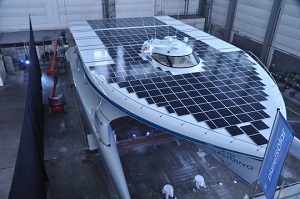Sun-powered vessel
 Who wouldn’t love to take an indefinite leave of absence from work and get on a yacht, catamaran, or sea fearing vessel of some kind to enjoy sipping white wine, eating shrimp cocktails, and pumping out jams by Michael McDonald and Christopher Cross? Well, if exploring the Earth’s vast oceans blasting yacht rock is a dream of yours, but you don’t want to make waves using petroleum to power your party, you may be in luck sooner than you think.
Who wouldn’t love to take an indefinite leave of absence from work and get on a yacht, catamaran, or sea fearing vessel of some kind to enjoy sipping white wine, eating shrimp cocktails, and pumping out jams by Michael McDonald and Christopher Cross? Well, if exploring the Earth’s vast oceans blasting yacht rock is a dream of yours, but you don’t want to make waves using petroleum to power your party, you may be in luck sooner than you think.
In the August 2010 edition of Popular Science, the Swiss company PlanetSolar SA announced the preparations for their giant solar-powered catamaran, appropriately named PlanetSolar, to make a world tour. This massive $15 million, 49-foot-wide, 25-foot-tall, 102-foot-long boat weighs in at a modest 94 tons. If you do the math, that translates into 5,380 square feet of solar panels, over a mile if you put them in a straight line, crammed onto the floating power station. Wondering what happens to the boat when there isn’t any sun? In the hulls of the ship, there are batteries that will store energy to power the boats four engines when cloudy.
PlanetSolar gave the world its first looks in February in Kiel, Germany, as the floating solar bed stunned audiences attending a local festival. Intended for large scale energy capture, the PlanetSolar project is finishing preparations to accomplish its hopes of completing the first 100 percent solar-powered circumnavigation of Earth.
Although not designed for recreational use, the boat is essentially a floating laboratory and has sparked the imagination of builders across the board on ways to integrate solar energy into their designs.
Although the ambitious feat of circling the globe is on PlanetSolar’s to-do list, pursuing alternative energy solutions is the primary goal behind this monster. In this month’s Popular Science, PlanetSolar’s scientific coordinator and COO Pascal Goulpie said, “[PlanetSolar] hopes the boat will inspire others to pursue alternative energy ventures throughout the next decade.”



